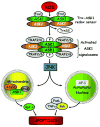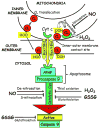Reactive oxygen species, cellular redox systems, and apoptosis
- PMID: 20045723
- PMCID: PMC2823977
- DOI: 10.1016/j.freeradbiomed.2009.12.022
Reactive oxygen species, cellular redox systems, and apoptosis
Abstract
Reactive oxygen species (ROS) are products of normal metabolism and xenobiotic exposure, and depending on their concentration, ROS can be beneficial or harmful to cells and tissues. At physiological low levels, ROS function as "redox messengers" in intracellular signaling and regulation, whereas excess ROS induce oxidative modification of cellular macromolecules, inhibit protein function, and promote cell death. Additionally, various redox systems, such as the glutathione, thioredoxin, and pyridine nucleotide redox couples, participate in cell signaling and modulation of cell function, including apoptotic cell death. Cell apoptosis is initiated by extracellular and intracellular signals via two main pathways, the death receptor- and the mitochondria-mediated pathways. Various pathologies can result from oxidative stress-induced apoptotic signaling that is consequent to ROS increases and/or antioxidant decreases, disruption of intracellular redox homeostasis, and irreversible oxidative modifications of lipid, protein, or DNA. In this review, we focus on several key aspects of ROS and redox mechanisms in apoptotic signaling and highlight the gaps in knowledge and potential avenues for further investigation. A full understanding of the redox control of apoptotic initiation and execution could underpin the development of therapeutic interventions targeted at oxidative stress-associated disorders.
Copyright 2010 Elsevier Inc. All rights reserved.
Figures



Similar articles
-
[Selenium compounds in redox regulation of inflammation and apoptosis].Biomed Khim. 2019 Apr;65(3):165-179. doi: 10.18097/PBMC20196503165. Biomed Khim. 2019. PMID: 31258141 Review. Russian.
-
Spatio-temporal changes in glutathione and thioredoxin redox couples during ionizing radiation-induced oxidative stress regulate tumor radio-resistance.Free Radic Res. 2015 Oct;49(10):1218-32. doi: 10.3109/10715762.2015.1056180. Free Radic Res. 2015. PMID: 26021764
-
Cellular thiols and reactive oxygen species in drug-induced apoptosis.J Pharmacol Exp Ther. 2001 Jan;296(1):1-6. J Pharmacol Exp Ther. 2001. PMID: 11123355 Review.
-
Redox control of cell death.Antioxid Redox Signal. 2002 Jun;4(3):405-14. doi: 10.1089/15230860260196209. Antioxid Redox Signal. 2002. PMID: 12215208 Review.
-
Reactive oxygen species (ROS) homeostasis and redox regulation in cellular signaling.Cell Signal. 2012 May;24(5):981-90. doi: 10.1016/j.cellsig.2012.01.008. Epub 2012 Jan 20. Cell Signal. 2012. PMID: 22286106 Free PMC article. Review.
Cited by
-
Proline Dehydrogenase (PRODH) Is Expressed in Lung Adenocarcinoma and Modulates Cell Survival and 3D Growth by Inducing Cellular Senescence.Int J Mol Sci. 2024 Jan 5;25(2):714. doi: 10.3390/ijms25020714. Int J Mol Sci. 2024. PMID: 38255788 Free PMC article.
-
Wide-field medium-repetition-rate multiphoton microscopy reduces photodamage of living cells.Biomed Opt Express. 2016 Mar 24;7(4):1458-67. doi: 10.1364/BOE.7.001458. eCollection 2016 Apr 1. Biomed Opt Express. 2016. PMID: 27446668 Free PMC article.
-
Satureja khuzestanica attenuates apoptosis in hyperglycemic PC12 cells and spinal cord of diabetic rats.J Nat Med. 2013 Jan;67(1):61-9. doi: 10.1007/s11418-012-0646-y. Epub 2012 Mar 2. J Nat Med. 2013. PMID: 22391800
-
A retrospective controlled study of thiol disulfide homeostasis as a novel marker in Crimean Congo hemorrhagic fever.Redox Rep. 2017 Nov;22(6):241-245. doi: 10.1080/13510002.2016.1178481. Epub 2016 May 9. Redox Rep. 2017. PMID: 27159644 Free PMC article.
-
Metabolic, autophagic, and mitophagic activities in cancer initiation and progression.Biomed J. 2016 Apr;39(2):98-106. doi: 10.1016/j.bj.2015.10.002. Epub 2016 Jun 8. Biomed J. 2016. PMID: 27372165 Free PMC article. Review.
References
-
- Andreyev AY, Kushnareva YE, Starkov AA. Mitochondrial metabolism of reactive oxygen species. Biochemistry (Mosc) 2005;70:200–214. - PubMed
Publication types
MeSH terms
Substances
Grants and funding
LinkOut - more resources
Full Text Sources
Other Literature Sources

